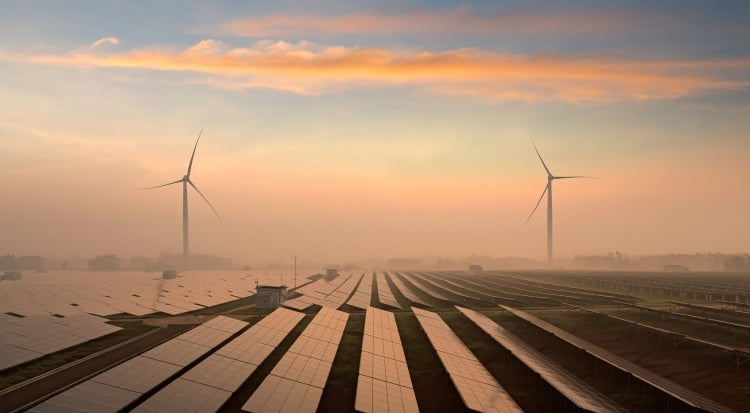
The global solar market will continue to slow in 2025 after 2024 saw the total capacity growth rate decrease by over 50%, according to a report from SolarPower Europe (SPE).
SPE said it expects global solar PV additions to grow by 10% in 2025, a significant decrease from 33% growth in 2024 and 87% growth in 2023. Its Global Solar Outlook 2025 report said that geopolitical tensions, trade uncertainties and a “macroeconomic context marked by uncertainty and stagnation” will cause this market stagnation.
Try Premium for just $1
- Full premium access for the first month at only $1
- Converts to an annual rate after 30 days unless cancelled
- Cancel anytime during the trial period
Premium Benefits
- Expert industry analysis and interviews
- Digital access to PV Tech Power journal
- Exclusive event discounts
Or get the full Premium subscription right away
Or continue reading this article for free
PV Tech has previously looked at the impact which tensions between China and the US, president Trump’s tariff regime and continuing economic challenges will have on the global solar industry.
Broadly, SPE said that “the surge in demand driven by the energy price crisis” of 2022-23 has subsided, while simultaneously, the overcapacity in Chinese PV manufacturing has kept prices low and supported the economics of solar development. “Global PV production capacity has reached approximately 1.2TW,” the report said, “Yet annual installations in 2024 amounted to only around 600 GW – just half of that capacity.”
In some sense, the decline in new additions is a return to some ‘normality’ after the exceptional growth of 2022 and 2023, SPE said. However, there are also long-term and specific challenges facing the solar sector over the coming years.
“2025 will mark a pivotal year for the global PV industry,” the report said. “While structural growth continues to be driven primarily by China and solar’s competitiveness due to its record low prices, unique versatility and further decreasing cost, external pressures are mounting from a strengthening fossil fuel lobby, macroeconomic conditions to geopolitical shifts, all of which is resulting in a higher degree of uncertainty, with market performance likely to diverge sharply based on how these risks evolve.”
Regional variation
As Europe’s solar industry gathers at the Intersolar show in Munich this week, SolarPower Europe’s report said that the continent will see the slowest growth of any region in 2025.
The Outlook forecast a “modest 3% rise” in European solar PV additions this year, which “reflects rather difficult market conditions.”
The largest European markets – Germany, Spain, France, Italy and Poland – are all expected to stagnate or decline. There are two main reasons for this: grid constraint and a flagging residential sector.
SPE highlighted grid constraint, permitting bottlenecks and the political uncertainty of Germany’s new government as roadblocks for its utility-scale solar sector, while Spain may see its market “contract” this year, “with low capture prices and curtailment compounding grid limitations.”
France, Italy, and Poland will all be held back by “weakness”, “policy uncertainty” and “decreased demand” in their respective residential and rooftop PV markets.
The utility-scale sector has the greatest potential for growth, SPE said (as exhibited by installation figures from Italy over the last year) but the sector is struggling what the report called “artificial saturation”, “with historical bottlenecks such as the lack of system flexibility requiring attention, now more than ever as power grids and policy frameworks have not kept pace with rapid solar growth.”
The US could reach an “inflexion point” in 2025, SPE said. Continued “modest” growth of 2.5% this year could be the last reliable growth figures for the foreseeable future as the fate of supportive tax credits and investment plans is thrown into uncertainty and Trump’s aggressive trade measures shake investor confidence in the US.
“In the medium term, we expect the situation to aggravate, undermine investor confidence and cause a downturn,” SPE said.
Southern and Central American countries are likely to continue to grow or remain relatively flat, according to SPE’s data: Chile is expected to grow by 15%, Brazil and Mexico will slow to a crawl, and Colombia will likely stabilise after a dramatic increase over 2024.
APAC is dominant
By contrast to Europe and the Americas, the Asia Pacific region – led by China and, secondarily, India – will “maintain robust growth through 2025”.
China will continue to meet around half of total global solar deployments in 2025, despite a “temporary dip” expected as the country reforms its solar market design. Despite slowing its projected growth to just 6% in 2025, China will still account for 53% of global capacity additions.
India – the third-largest PV market in 2024 – is on track to grow by 21% in 2025 as the government’s competitive auctions and robust policy support for solar continue to bear fruit. The government issued a massive 73GW worth of utility-scale renewable energy tenders in 2024, an all-time record.






